Mary Teresa Norton
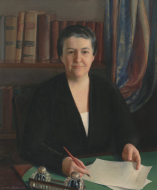 /tiles/non-collection/w/wic_artifacts_norton_2003_024_001.xml
/tiles/non-collection/w/wic_artifacts_norton_2003_024_001.xml
"Battling Mary" Norton represented her Jersey City, New Jersey district for 12 terms, defending the interests of her blue collar constituency. Norton’s career was marked by her chairmanship of four committees, most notably the Committee on Labor, during which she accomplished greatest legislative achievement. The Fair Labor Standards Act of 1938 established the 40 hour work week, outlawed child labor, and set a minimum wage of 25 cents an hour. Dedicated to improving the lives of the working class, Norton said, "I’m prouder of getting that bill through the House than anything else I’ve done in my life."
Leonor Kretzer Sullivan
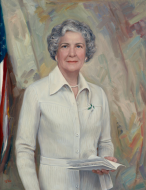 /tiles/non-collection/w/wic_artifacts_sullivan_portrait_2002_015_009.xml
/tiles/non-collection/w/wic_artifacts_sullivan_portrait_2002_015_009.xml
Shown here in the Chair portrait commemorating her leadership of the Committee on Merchant Marine and Fisheries (now Natural Resources), Leonor Sullivan was the first Missouri woman elected to Congress. Sullivan was an early advocate for consumers, working on legislation including the Consumer Credit Protection Act of 1968 and consumer protection from hazardous substances.
Shirley Anita Chisholm
Shirley Chisholm, the first African-American woman elected to Congress, represented a Brooklyn district for more than a decade. In 2009, the House of Representatives honored her pathbreaking service with a newly commissioned portrait. Congresswoman Chisholm’s independence and outspokenness are on full display in the portrait’s bold portrayal of the legendary lawmaker.
Katherine Langley Campaign Card
 /tiles/non-collection/w/wic_artifacts_langley_card_2006_183_000.xml
/tiles/non-collection/w/wic_artifacts_langley_card_2006_183_000.xml
After her husband, John Langley of Kentucky was convicted of “conspiracy to violate the Prohibition Act,” Katherine Langley won his former seat, and served two terms in Congress.
Collection of the U.S. House of Representatives
About this object
Edith Nourse Rogers Handbill
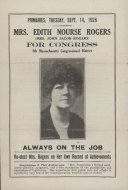 /tiles/non-collection/w/wic_artifacts_rogers_handbill_2008_270_000.xml
/tiles/non-collection/w/wic_artifacts_rogers_handbill_2008_270_000.xml
This handbill for Massachusetts Congresswoman Edith Nourse Rogers’ second term campaign touts her experience and judgment as a legislator. It also includes praise from fellow Bay State Representative A. Platt Andrew who stated that her “experience with public men and affairs is equaled by very few of her contemporaries, whether men or women.” At a time when few women served beyond the “widow’s mandate,” Rogers’ was forming the basis of a long and successful career in the House, becoming the chair of the Veterans Affairs Committee in 1947.
Collection of the U.S. House of Representatives
About this object
Jeannette Rankin Button
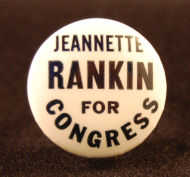 /tiles/non-collection/w/wic_artifacts_rankin_button_2006_238_000-2.xml
/tiles/non-collection/w/wic_artifacts_rankin_button_2006_238_000-2.xml
Montana Representative Jeannette Rankin, the first woman to serve in Congress and a noted pacifist, served two non-consecutive terms, 1917–1919 and 1941–1943. This button was made for her second successful campaign, during the looming crisis of World War II. In the vote for the declaration of war on Japan, she was the only Member to vote no.
Collection of the U.S. House of Representatives
About this object
Helen Gahagan Douglas Button
 /tiles/non-collection/w/wic_artifacts_douglas_campaign_pin_2007_243_007.xml
/tiles/non-collection/w/wic_artifacts_douglas_campaign_pin_2007_243_007.xml
Outspoken former actress Helen Gahagan Douglas of California became a spokesperson for liberal causes in the post-war era. Inspired to enter politics due to the widespread suffering she witnessed in the west during the Great Depression, Douglas spoke up for desegregation and labor rights, challenging reactionary policies such as the Committee on Un-American Activities and military oversight of nuclear research.
Collection of the U.S. House of Representatives
About this object
Winifred Stanley Postcard
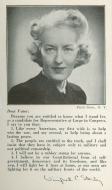 /tiles/non-collection/w/wic_artifacts_stanley_postcard_2007_078_000.xml
/tiles/non-collection/w/wic_artifacts_stanley_postcard_2007_078_000.xml
Winifred Stanley, an accomplished attorney and women’s rights advocate, served a single term representing Erie County, NY. She was the first Member to introduce an equal pay for equal work bill, and supported a constitutional elimination of the poll tax. Though she won her one election in a landslide, her at-large district was destined to be redrawn, and the Republican party did not support her renomination in the new district.
Collection of the U.S. House of Representatives
Marguerite Stitt Church Advertisement
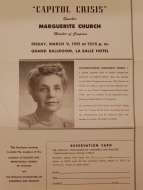 /tiles/non-collection/w/wic_artifacts_church_advertisement_2006_192_000.xml
/tiles/non-collection/w/wic_artifacts_church_advertisement_2006_192_000.xml
When questioned as to whether her foreign aid investigations in Asia were proper for a lady, Marguerite Stitt Church of Illinois replied, “I’m no lady, I’m a Member of Congress.” The lecture advertised in this flyer occurred at the beginning of her 12-year House career, which began when she won her deceased husband’s vacated seat in 1951.
Collection of the U.S. House of Representatives
Cecil Harden Thimble
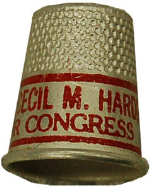 /tiles/non-collection/w/wic_artifacts_harden_thimble_2008_035_000.xml
/tiles/non-collection/w/wic_artifacts_harden_thimble_2008_035_000.xml
Early in her career, Cecil Murray Harden of Indiana stated the “the more interest you take in politics, the more you meet your responsibilities as a citizen.” A Republican who represented her Indiana district from 1949–1959, Harden encouraged her party to add women’s issues to their platform, and co-sponsored a 1957 equal pay for women bill. The choice of the thimble for a campaign hand-out suggests Harden’s targeting of women voters and hopes for engaging them as fully as possible as citizens.
Collection of the U.S. House of Representatives
Edith Green Notepad
 /tiles/non-collection/w/wic_artifacts_edith_green_2005_167_000.xml
/tiles/non-collection/w/wic_artifacts_edith_green_2005_167_000.xml
After a career as an educator, radio announcer, and legislative chairperson of the Oregon Congress of Parents and Teachers, Edith Green ran for Congress in 1954. This notepad hails from that first campaign, which began her 20 year career as a Member.
Collection of the U.S. House of Representatives
About this object
Coya Knutson Campaign Button
 /tiles/non-collection/w/wic_artifacts_knutson_campaign_pin_2007_243_005.xml
/tiles/non-collection/w/wic_artifacts_knutson_campaign_pin_2007_243_005.xml
Coming to politics via community activism, Coya Knutson worked diligently to support her agriculturally-centered district in northwestern Minnesota. Also firmly believing that, as a nation, we could not “take the risk of limiting education to only those who can afford it,” Knutson wrote a measure creating the first mechanisms for a federal student financial aid program.
Edna Kelly Button
 /tiles/non-collection/w/wic_artifacts_kelly_campaign_pin_2007_243_004.xml
/tiles/non-collection/w/wic_artifacts_kelly_campaign_pin_2007_243_004.xml
New York Congresswoman Edna Kelly’s main contributions to the House came via her position on the Foreign Affairs Committee, on which she served as chair of the Subcommittee on Europe. Strongly anti-communist and deeply concerned about Arab-Israeli relations, Kelly’s network of international contacts were legendary, with a colleague remarking that travelling with Kelly was “like going abroad with Mata Hari. She had innumerable contacts…that were not available to the State Department.”
Collection of the U.S. House of Representatives
Edith Green Button
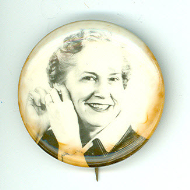 /tiles/non-collection/w/wic_artifacts_green_campaign_pin_2007_243_008.xml
/tiles/non-collection/w/wic_artifacts_green_campaign_pin_2007_243_008.xml
By the time this campaign button for Edith Green of Oregon appeared, she had gained a reputation as “the Mother of Higher Education,” due to her work on the National Defense Education Act. Green went on to author the Higher Education Act, which President Lyndon B. Johnson called the “greatest step forward in the field in 100 years.”
Collection of the U.S. House of Representatives
Catherine May Postcard
 /tiles/non-collection/w/wic_artifacts_may_postcard_2006_211_000.xml
/tiles/non-collection/w/wic_artifacts_may_postcard_2006_211_000.xml
Upon her election to the House in 1965, Catherine May of Washington stated that she felt “a tremendous feeling of responsibility toward all women.” Shown here in a re-election campaign postcard, May was a great supporter of the agricultural needs of her constituents, as well as women’s issues such as the sex discrimination clause in the 1964 Civil Rights Act and the Equal Rights Amendment.
Collection of the U.S. House of Representatives
Julia Butler Hansen Button
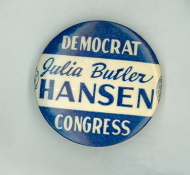 /tiles/non-collection/w/wic_artifacts_hansen_campaign_pin_2007_243_003.xml
/tiles/non-collection/w/wic_artifacts_hansen_campaign_pin_2007_243_003.xml
An experienced legislator at the state level when she entered the House in 1960, Julia Butler Hansen of Washington liked “the rough and tumble of legislation.” Her skills were rewarded when she became the second woman ever to be on the Appropriations Committee, and the first woman to chair one of its subcommittees.
Collection of the U.S. House of Representatives
Frances Bolton Postcard
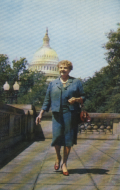 /tiles/non-collection/w/wic_artifacts_Bolton_card_2008_120_000.xml
/tiles/non-collection/w/wic_artifacts_Bolton_card_2008_120_000.xml
This re-election postcard shows Frances Bolton, Republican from Ohio, who served in Congress from 1940–1968. Bolton began her long House career by winning her late husband’s seat, becoming the first woman elected from Ohio. She was later the first woman to serve simultaneously with her son, Oliver Bolton.
Collection of the U.S. House of Representatives
Bella Abzug Handbill
 /tiles/non-collection/w/wic_artifacts_abzug_handbill_2007_224_000.xml
/tiles/non-collection/w/wic_artifacts_abzug_handbill_2007_224_000.xml
This campaign handbill outlines colorful New York Member Bella Abzug’s strong opinions on a number of issues—her stance against the Vietnam War, her support of working families and affordable health care. A feminist and community activist, Abzug was distinctive for both her signature hats and her outspoken style.
Collection of the U.S. House of Representatives
Patsy Mink Campaign Button
 /tiles/non-collection/w/wic_artifacts_mink_campaign_pin_2007_063_001.xml
/tiles/non-collection/w/wic_artifacts_mink_campaign_pin_2007_063_001.xml
The first woman of color to be elected to the House of Representatives, Patsy Mink of Hawaii was a strong advocate for the Great Society legislation of the 1960s during her first stint in Congress, from 1965–1977. Mink introduced the first childcare bill, as well as bills supporting student loans and Head Start programs.
Collection of the U.S. House of Representatives
Louise Day Hicks Campaign Button
Best known for her harsh criticism of busing as a means of addressing racial segregation in public schools, Louise Day Hicks, represented her Boston district for one term.
Collection of the U.S. House of Representatives
Pat Schroeder Campaign Button
 /tiles/non-collection/w/wic_artifacts_schroeder_campaign_pin_2007_160_002.xml
/tiles/non-collection/w/wic_artifacts_schroeder_campaign_pin_2007_160_002.xml
At first dismissed by some Members as “Little Patsy,” Colorado Congresswoman Pat Schroeder became a forceful advocate for liberal issues during her 24-year congressional career. She initially campaigned as an anti-Vietnam War candidate, but her issues subsequently encompassed topics from reproductive rights to arms control.
Collection of the U.S. House of Representatives
Shirley Chisholm for President Campaign Button
 /tiles/non-collection/w/wic_artifacts_chisholm_campaign_pin_2007_073_000.xml
/tiles/non-collection/w/wic_artifacts_chisholm_campaign_pin_2007_073_000.xml
A bold and outspoken Member of Congress, Shirley Chisholm of New York continued to challenge expectations with her 1972 campaign for the Democratic presidential nomination. Though largely a symbolic undertaking, she was the first serious black woman candidate for a major party, following her 1968 achievement of becoming the first black woman in Congress. As suggested by the design of this button for that landmark campaign, Chisholm found her gender a greater hurdle than her race in her political career.
Helen Meyner Campaign Button
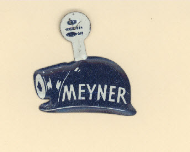 /tiles/non-collection/w/wic_artifacts_meyner_campaign_pin_2008_065_001.xml
/tiles/non-collection/w/wic_artifacts_meyner_campaign_pin_2008_065_001.xml
Helen Meyner, a New Jersey Democrat, served in Congress from 1975–1979. She was known for her human rights advocacy and her work on the Foreign Affairs Committee.
Collection of the U.S. House of Representatives
Margaret Heckler Bumper Sticker
 /tiles/non-collection/w/wic_artifacts_heckler_2007_183_008.xml
/tiles/non-collection/w/wic_artifacts_heckler_2007_183_008.xml
A Republican representing a heavily Democratic-leaning Massachusetts district, Margaret Heckler focused on constituent issues and women’s rights throughout her 16-year career in the House. Co-chairing the first congressional Women’s Caucus with Elizabeth Holtzman, Heckler supported legislation on domestic violence prevention and prohibition of discrimination in acquiring credit.
Collection of the U.S. House of Representatives
Liz Holtzman Campaign Button
 /tiles/non-collection/w/wic_artifacts_holtzman_campaign_pin_2008_066_001.xml
/tiles/non-collection/w/wic_artifacts_holtzman_campaign_pin_2008_066_001.xml
After defeating 50-year House veteran Emanuel Celler for the Democratic nomination for the Brooklyn, New York district, Liz Holtzman became the youngest woman to serve in the House, at 31. During her tenure, from 1971 to 1981, Holtzman earned national prominence for her work on the Judiciary Committee during the Nixon impeachment inquiry.
Collection of the U.S. House of Representatives
Geraldine Ferraro Campaign Button
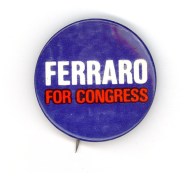 /tiles/non-collection/w/wic_artifacts_ferraro_campaign_pin_2007_248_002.xml
/tiles/non-collection/w/wic_artifacts_ferraro_campaign_pin_2007_248_002.xml
While serving her Queens district, New York Congresswoman Geraldine Ferraro became the first woman Vice-Presidential candidate on a major party ticket in the 1984 Presidential Election. A member of the Committee on Budget, Ferraro sponsored the Economic Equality Act of 1981.
Millicent Fenwick Campaign Button
 /tiles/non-collection/w/wic_artifacts_fenwick_campaign_pin_2007_020_000.xml
/tiles/non-collection/w/wic_artifacts_fenwick_campaign_pin_2007_020_000.xml
A longtime aide described blue-blooded patrician Millicent Fenwick of New Jersey as “the Katherine Hepburn of politics. With her dignity and elegance, she could get away with saying things others couldn’t.” Fenwick also earned the nickname “the conscious of Congress” for her dedication to campaign finance reform and the rehabilitation of government in the midst of Watergate and numerous Congressional scandals.
Collection of the U.S. House of Representatives
Mary Rose Oakar Campaign Button
 /tiles/non-collection/w/wic_artifacts_Oakar_campaign_pin_2007_247_002.xml
/tiles/non-collection/w/wic_artifacts_Oakar_campaign_pin_2007_247_002.xml
During her 16 years in Congress, Mary Rose Oakar of Ohio developed a reputation as a liberal who worked on behalf of women’s rights, most notably with her sponsorship of the Pay Equity Act and the Federal Pay Equity Act in the mid-1980s. She believed that “economic security is the truly liberating issue for women…if you’re economically liberated, you’re free to pursue other avenues in your life.”
Collection of the U.S. House of Representatives
Cardiss Collins Campaign Button
 /tiles/non-collection/w/wic_artifacts_collins_campaign_pin_2007_238_004.xml
/tiles/non-collection/w/wic_artifacts_collins_campaign_pin_2007_238_004.xml
Following the unexpected death of George W. Collins of Illinois, his widow, Cardiss Collins, won the special election for his seat. Congresswoman Collins served the district for nearly 24 years. She served as Chair of the Congressional Black Caucus, and worked throughout her career to guard against discrimination in several industries and in college athletics.
Collection of the U.S. House of Representatives
Lindy Boggs Campaign Button
 /tiles/non-collection/w/wic_artifacts_boggs_campaign_pin_2007_253_002.xml
/tiles/non-collection/w/wic_artifacts_boggs_campaign_pin_2007_253_002.xml
As this 1988 campaign button declares, Lindy Boggs was a much-loved representative for her Louisiana district. During her 18-year House career, she ran unopposed in all but three elections, and won her seat by large margins. Beginning her House career after the death of her husband Hale Boggs, an influential Member and Majority Leader, Lindy Boggs stated that “the only thing that almost stopped me was that I didn’t know how I could do it without a wife.”
Collection of the U.S. House of Representatives
Connie Morella Campaign Button
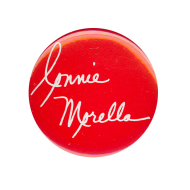 /tiles/non-collection/w/wic_artifacts_morella_campaign_pin_2007_239_002.xml
/tiles/non-collection/w/wic_artifacts_morella_campaign_pin_2007_239_002.xml
A popular figure in her Maryland district, the Washington Post quipped in 1992, “Three things are certain in Montgomery County…death, taxes and Connie Morella showing up for every small-town parade and public forum.” A moderate Republican, Morella focused on issues effecting her district, strongly supporting federal employees and the national Institute of Standards and Technology.
Collection of the U.S. House of Representatives
Barbara Kennelly Campaign Button
 /tiles/non-collection/w/wic_artifacts_kenneally_campaign_pin_2008_135_003.xml
/tiles/non-collection/w/wic_artifacts_kenneally_campaign_pin_2008_135_003.xml
Barbara Kennelly, a Democrat from Connecticut, served in Congress from 1981–1998. During her tenure, she became one of the highest-ranking women to date in the history of the Democratic party, serving on the powerful Ways and Means Committee and as Vice Chairman of the Democratic Caucus.
Collection of the U.S. House of Representatives
Susan Molinari Campaign Button
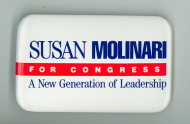 /tiles/non-collection/w/wic_artifacts_molinari_campaign_pin_2007_237_004.xml
/tiles/non-collection/w/wic_artifacts_molinari_campaign_pin_2007_237_004.xml
Following in her father Guy Molinari’s footsteps, Susan Molinari represented Staten Island, NY, in the House. A moderate Republican, she was a party star in the 1990s, serving as Vice-Chair of the Republican Conference and delivering the keynote address at the 1996 Republican National Convention.
Collection of the U.S. House of Representatives
Tillie Fowler Campaign Button
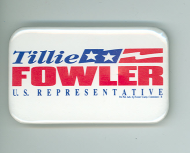 /tiles/non-collection/w/wic_artifacts_fowler_campaign_pin_2007_237_003.xml
/tiles/non-collection/w/wic_artifacts_fowler_campaign_pin_2007_237_003.xml
Tillie Fowler of Florida believed that women could have a unique impact on Congress, but not in traditional terms, saying “…I don’t believe that there is any one set of issues that is just women’s issues—I think women’s perspective is needed in defense…” Fowler was part of the Armed Services Committee, and was also Vice-Chair of the GOP Conference, the 5th-ranking Republican in the House, and the highest ranking woman in the party.
Collection of the U.S. House of Representatives
Elizabeth Furse Campaign Button
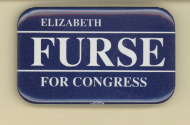 /tiles/non-collection/w/wic_artifacts_furse_campaign_pin_2007_062_001.xml
/tiles/non-collection/w/wic_artifacts_furse_campaign_pin_2007_062_001.xml
Anti-apartheid activist and advocate for migrant farm workers and Native Americans, Elizabeth Furse of Oregon was also dedicated to nuclear non-proliferation. After co-sponsoring a successful ban on research and development of low-yield nuclear warheads, she said “I introduced an amendment…that killed an entire generation of nuclear weapons...If I do nothing else, it makes going [to D.C.] worthwhile.”
Collection of the U.S. House of Representatives
Eva Clayton Campaign Button
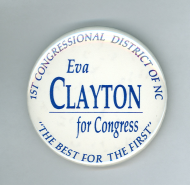 /tiles/non-collection/w/wic_artifacts_clayton_campaign_pin_2008_047_014.xml
/tiles/non-collection/w/wic_artifacts_clayton_campaign_pin_2008_047_014.xml
Eva Clayton was the first African-American woman to represent North Carolina, as well as the state’s first black Member of Congress since George Henry White left office in 1901. During her service, Clayton created a high profile for herself as an advocate for programs to help economically disadvantaged African-Americans as well as small farm owners.
Collection of the U.S. House of Representatives
Cynthia McKinney Campaign Button
 /tiles/non-collection/w/wic_artifacts_mckinney_campaign_pin_2008_047_007.xml
/tiles/non-collection/w/wic_artifacts_mckinney_campaign_pin_2008_047_007.xml
Cynthia McKinney, the first African-American woman to represent Georgia, was known both for her unconventional attire (including her signature gold tennis shoes) and her willingness to speak out on issues of injustice. As a member of the International Relations Committee, McKinney worked to pass the Arms Transfers Code of Conduct to prevent weapons sales to dictators.
Collection of the U.S. House of Representatives
Stephanie Tubbs Jones Campaign Button
 /tiles/non-collection/w/wic_artifacts_jones_campaign_pin_2008_047_017.xml
/tiles/non-collection/w/wic_artifacts_jones_campaign_pin_2008_047_017.xml
Stephanie Tubbs-Jones became the first African-American woman to represent Ohio in the U.S. House of Representatives. In order to best serve her Cleveland constituents, Tubbs-Jones focused on financial literacy, health care access and education.
Collection of the U.S. House of Representatives
Nancy Pelosi Speaker of the House Button
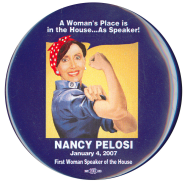 /tiles/non-collection/w/wic_artifacts_pelosi_pin_2007_108_000.xml
/tiles/non-collection/w/wic_artifacts_pelosi_pin_2007_108_000.xml
California Representative Nancy Pelosi’s election as Speaker of the House in the 110th Congress is celebrated in this button, which adapts the iconic World War II “Rosie the Riveter” image. The first woman to “break the marble ceiling,” Pelosi is the only woman to hold any of a major party’s top three leadership positions.
Collection of the U.S. House of Representatives
Florence Prag Kahn
 /tiles/non-collection/e/ex_kahn_hc_2009_005_000.xml
/tiles/non-collection/e/ex_kahn_hc_2009_005_000.xml
In 1925, Florence Prag Kahn succeeded her late husband Julius in a San Francisco-based U.S. House seat. Most early congressional widows served as temporary placeholders until party leaders chose long-term, male successors. But Kahn was no ordinary political widow. With an insider’s knowledge of House operations and a gift for turning a phrase, she set herself to “attending to business”—expanding the Bay Area’s infrastructure and military installations during her 12-year career, while blazing a trail for women seeking political office.
Gallery Pass
 /tiles/non-collection/w/wic_artifacts_rankin_pass_2006_184_000.xml
/tiles/non-collection/w/wic_artifacts_rankin_pass_2006_184_000.xml
This Visitor’s Gallery pass was signed by Jeannette Rankin in 1917, the year she entered Congress as its first and only woman Member. During her first floor debate on women’s suffrage, she challenged her fellow Members asking, “How shall we explain…the meaning of democracy if the same Congress that voted to make the world safe for democracy refuses to give this small measure of democracy to the women of our country?”
Edith Nourse Rogers
 /tiles/non-collection/w/wic_artifacts_rogers_at_the_rostrum_2008_123_001.xml
/tiles/non-collection/w/wic_artifacts_rogers_at_the_rostrum_2008_123_001.xml
Edith Nourse Rogers of Massachusetts served as the presiding officer in 1926. The longest serving woman in House history with 35 years of experience, Rogers later became one of the first women to chair a standing committee.
Collection of the U.S. House of Representatives, Photography Collection
About this object
World's Fastest Tank Demonstrated Before Congressmen at the Capitol
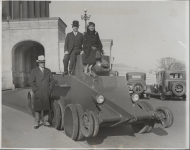 /tiles/non-collection/w/wic_artifacts_rogers_on_tank_2008_137_000.xml
/tiles/non-collection/w/wic_artifacts_rogers_on_tank_2008_137_000.xml
Edith Nourse Rogers of Massachusetts, along with John Cooper of Ohio and Randolph Perkins of New Jersey, experience first-hand the world’s fastest tank in an early 1930s military demonstration at the Capitol. Rogers’ legislative career focused upon military and veterans’ issues, and included work on the G.I. Bill, which assisted many military veterans attending college.
Collection of the U.S. House of Representatives, Photography Collection
About this object
Gallery Pass
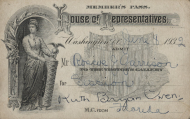 /tiles/non-collection/w/wic_artifacts_owen_pass_2008_179_000.xml
/tiles/non-collection/w/wic_artifacts_owen_pass_2008_179_000.xml
The daughter of William Jennings Bryan of Nebraska, Ruth Bryan Owen of Florida followed her father’s example by pursuing a reform agenda in the House. This 1932 Visitor’s Gallery pass, with Owen's signature, serves as an apt symbol for her service, as she was dedicated to her constituents, utilizing a “resident secretary” in her large Florida district to poll constituents and keep abreast of local happenings. She also hosted groups of district high school students annually to educate them on public service and enable a visit to the capital.
Collection of the U.S. House of Representatives
Virginia Ellis Jenckes
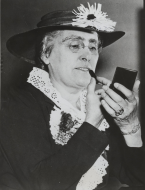 /tiles/non-collection/w/wic_artifacts_jenckes_2008_178_004.xml
/tiles/non-collection/w/wic_artifacts_jenckes_2008_178_004.xml
Virginia Jenckes of Indiana worked to end the luxury tax on cosmetics in 1936, arguing that lipstick was a necessity for many women. She stated publically that women needed to organize and protest to fight the unfair levy.
Collection of the U.S. House of Representatives, Photography Collection
About this object
Clare Boothe Luce
 /tiles/non-collection/w/wic_artifacts_luce_photo_2007_197_000_3.xml
/tiles/non-collection/w/wic_artifacts_luce_photo_2007_197_000_3.xml
Clare Boothe Luce of Connecticut visits with a soldier in a South African hospital in Italy in March of 1945. Luce’s interests as a legislator had an internationalist bent, and she described her guiding philosophy as “America first but not only.” Luce supported much of the Roosevelt administration’s foreign policy, including a strong alliance with Britain and the U.S.’s involvement in the United Nations Refugee Relief Agency.
Collection of the U.S. House of Representatives, Photography Collection
About this object
Women Members of the 83rd Congress
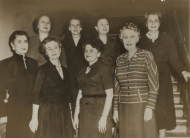 /tiles/non-collection/w/wic_artifacts_congresswomen_at_the_start_2008_194_000.xml
/tiles/non-collection/w/wic_artifacts_congresswomen_at_the_start_2008_194_000.xml
This group photo taken at the beginning of the 83rd Congress (1953–1955) includes Edna Kelly of New York, Katherine St. George of New York, Gracie Pfost of Idaho, Ruth Thompson of Michigan, Elizabeth Kee of West Virginia, Leonor Sullivan of Missouri, Vera Buchanan of Pennsylvania and Marguerite Church of Illinois.
Collection of the U.S. House of Representatives, Photography Collection
About this object
Shirley Pettis Greeting Card
 /tiles/non-collection/w/wic_artifacts_pettis_card_2007_183_000.xml
/tiles/non-collection/w/wic_artifacts_pettis_card_2007_183_000.xml
In this holiday card to constituents, California Republican Shirley Pettis poses in front of the memorial chapel dedicated to her late husband, Representative Jerry Pettis. Shirley won his seat and made her mark in Congress addressing environmental issues effecting her CA district, including the establishment of the first solar power plant in the nation in her district, and securing the California desert as a conservation area.
Collection of the U.S. House of Representatives
Margaret Chase Smith Supersisters Card
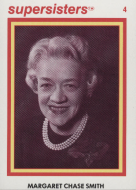 /tiles/non-collection/w/wic_artifacts_smith_supersisters_card_2007_038_002.xml
/tiles/non-collection/w/wic_artifacts_smith_supersisters_card_2007_038_002.xml
This 1979 Supersisters card for Margaret Chase Smith of Maine was issued after she left the Senate in 1972, a testament to her status as a role model for women in Congress. The first woman to serve in both branches, Smith’s long career - nine years in the House and 23 years in the Senate - was marked by independence and courageousness as a legislator. A well-known example of her fortitude is her 1950 “Declaration of Conscience” speech, in which she denounced her fellow Senator Joseph McCarthy of Wisconsin for exploiting fear and intolerance.
Collection of the U.S. House of Representatives
Gladys Noon Spellman Supersisters Card
 /tiles/non-collection/w/wic_artifacts_spellman_supersisters_card_2007_038_006.xml
/tiles/non-collection/w/wic_artifacts_spellman_supersisters_card_2007_038_006.xml
Nicknamed “Madame Tinkerbell” by a colleague early in her political career due to her ebullient and engaging personality, Gladys Noon Spellman of Maryland appears characteristically cheerful in a Supersisters card - a group of woman Members supporting their party’s Congressional Baseball team. A great advocate of federal workers and a reformer of House procedures, Spellman became one of the most popular figures in Maryland politics.
Collection of the U.S. House of Representatives
Jet Magazine
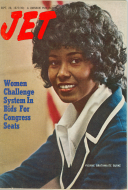 /tiles/non-collection/w/wic_artifacts_burke_jet_magazine_2007_370_000.xml
/tiles/non-collection/w/wic_artifacts_burke_jet_magazine_2007_370_000.xml
In the year she that she earned national recognition for wielding the gavel as Vice-Chair at the sometimes-raucous 1972 Democratic National Convention, Yvonne Brathwaite Burke is featured on the cover of Jet magazine. That same year, she won a seat in Congress, becoming the first black woman to represent California, and the third black woman in Congress.
Collection of the U.S. House of Representatives
 /tiles/non-collection/w/wic_artifacts_norton_2003_024_001.xml
/tiles/non-collection/w/wic_artifacts_norton_2003_024_001.xml
 /tiles/non-collection/w/wic_artifacts_sullivan_portrait_2002_015_009.xml
/tiles/non-collection/w/wic_artifacts_sullivan_portrait_2002_015_009.xml

 /tiles/non-collection/w/wic_artifacts_langley_card_2006_183_000.xml
/tiles/non-collection/w/wic_artifacts_langley_card_2006_183_000.xml
 /tiles/non-collection/w/wic_artifacts_rogers_handbill_2008_270_000.xml
/tiles/non-collection/w/wic_artifacts_rogers_handbill_2008_270_000.xml
 /tiles/non-collection/w/wic_artifacts_rankin_button_2006_238_000-2.xml
/tiles/non-collection/w/wic_artifacts_rankin_button_2006_238_000-2.xml
 /tiles/non-collection/w/wic_artifacts_douglas_campaign_pin_2007_243_007.xml
/tiles/non-collection/w/wic_artifacts_douglas_campaign_pin_2007_243_007.xml
 /tiles/non-collection/w/wic_artifacts_stanley_postcard_2007_078_000.xml
/tiles/non-collection/w/wic_artifacts_stanley_postcard_2007_078_000.xml
 /tiles/non-collection/w/wic_artifacts_church_advertisement_2006_192_000.xml
/tiles/non-collection/w/wic_artifacts_church_advertisement_2006_192_000.xml
 /tiles/non-collection/w/wic_artifacts_harden_thimble_2008_035_000.xml
/tiles/non-collection/w/wic_artifacts_harden_thimble_2008_035_000.xml
 /tiles/non-collection/w/wic_artifacts_edith_green_2005_167_000.xml
/tiles/non-collection/w/wic_artifacts_edith_green_2005_167_000.xml
 /tiles/non-collection/w/wic_artifacts_knutson_campaign_pin_2007_243_005.xml
/tiles/non-collection/w/wic_artifacts_knutson_campaign_pin_2007_243_005.xml
 /tiles/non-collection/w/wic_artifacts_kelly_campaign_pin_2007_243_004.xml
/tiles/non-collection/w/wic_artifacts_kelly_campaign_pin_2007_243_004.xml
 /tiles/non-collection/w/wic_artifacts_green_campaign_pin_2007_243_008.xml
/tiles/non-collection/w/wic_artifacts_green_campaign_pin_2007_243_008.xml
 /tiles/non-collection/w/wic_artifacts_may_postcard_2006_211_000.xml
/tiles/non-collection/w/wic_artifacts_may_postcard_2006_211_000.xml
 /tiles/non-collection/w/wic_artifacts_hansen_campaign_pin_2007_243_003.xml
/tiles/non-collection/w/wic_artifacts_hansen_campaign_pin_2007_243_003.xml
 /tiles/non-collection/w/wic_artifacts_Bolton_card_2008_120_000.xml
/tiles/non-collection/w/wic_artifacts_Bolton_card_2008_120_000.xml
 /tiles/non-collection/w/wic_artifacts_abzug_handbill_2007_224_000.xml
/tiles/non-collection/w/wic_artifacts_abzug_handbill_2007_224_000.xml
 /tiles/non-collection/w/wic_artifacts_mink_campaign_pin_2007_063_001.xml
/tiles/non-collection/w/wic_artifacts_mink_campaign_pin_2007_063_001.xml
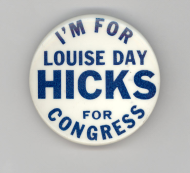
 /tiles/non-collection/w/wic_artifacts_schroeder_campaign_pin_2007_160_002.xml
/tiles/non-collection/w/wic_artifacts_schroeder_campaign_pin_2007_160_002.xml
 /tiles/non-collection/w/wic_artifacts_chisholm_campaign_pin_2007_073_000.xml
/tiles/non-collection/w/wic_artifacts_chisholm_campaign_pin_2007_073_000.xml
 /tiles/non-collection/w/wic_artifacts_meyner_campaign_pin_2008_065_001.xml
/tiles/non-collection/w/wic_artifacts_meyner_campaign_pin_2008_065_001.xml
 /tiles/non-collection/w/wic_artifacts_heckler_2007_183_008.xml
/tiles/non-collection/w/wic_artifacts_heckler_2007_183_008.xml
 /tiles/non-collection/w/wic_artifacts_holtzman_campaign_pin_2008_066_001.xml
/tiles/non-collection/w/wic_artifacts_holtzman_campaign_pin_2008_066_001.xml
 /tiles/non-collection/w/wic_artifacts_ferraro_campaign_pin_2007_248_002.xml
/tiles/non-collection/w/wic_artifacts_ferraro_campaign_pin_2007_248_002.xml
 /tiles/non-collection/w/wic_artifacts_fenwick_campaign_pin_2007_020_000.xml
/tiles/non-collection/w/wic_artifacts_fenwick_campaign_pin_2007_020_000.xml
 /tiles/non-collection/w/wic_artifacts_Oakar_campaign_pin_2007_247_002.xml
/tiles/non-collection/w/wic_artifacts_Oakar_campaign_pin_2007_247_002.xml
 /tiles/non-collection/w/wic_artifacts_collins_campaign_pin_2007_238_004.xml
/tiles/non-collection/w/wic_artifacts_collins_campaign_pin_2007_238_004.xml
 /tiles/non-collection/w/wic_artifacts_boggs_campaign_pin_2007_253_002.xml
/tiles/non-collection/w/wic_artifacts_boggs_campaign_pin_2007_253_002.xml
 /tiles/non-collection/w/wic_artifacts_morella_campaign_pin_2007_239_002.xml
/tiles/non-collection/w/wic_artifacts_morella_campaign_pin_2007_239_002.xml
 /tiles/non-collection/w/wic_artifacts_kenneally_campaign_pin_2008_135_003.xml
/tiles/non-collection/w/wic_artifacts_kenneally_campaign_pin_2008_135_003.xml
 /tiles/non-collection/w/wic_artifacts_molinari_campaign_pin_2007_237_004.xml
/tiles/non-collection/w/wic_artifacts_molinari_campaign_pin_2007_237_004.xml
 /tiles/non-collection/w/wic_artifacts_fowler_campaign_pin_2007_237_003.xml
/tiles/non-collection/w/wic_artifacts_fowler_campaign_pin_2007_237_003.xml
 /tiles/non-collection/w/wic_artifacts_furse_campaign_pin_2007_062_001.xml
/tiles/non-collection/w/wic_artifacts_furse_campaign_pin_2007_062_001.xml
 /tiles/non-collection/w/wic_artifacts_clayton_campaign_pin_2008_047_014.xml
/tiles/non-collection/w/wic_artifacts_clayton_campaign_pin_2008_047_014.xml
 /tiles/non-collection/w/wic_artifacts_mckinney_campaign_pin_2008_047_007.xml
/tiles/non-collection/w/wic_artifacts_mckinney_campaign_pin_2008_047_007.xml
 /tiles/non-collection/w/wic_artifacts_jones_campaign_pin_2008_047_017.xml
/tiles/non-collection/w/wic_artifacts_jones_campaign_pin_2008_047_017.xml
 /tiles/non-collection/w/wic_artifacts_pelosi_pin_2007_108_000.xml
/tiles/non-collection/w/wic_artifacts_pelosi_pin_2007_108_000.xml
 /tiles/non-collection/e/ex_kahn_hc_2009_005_000.xml
/tiles/non-collection/e/ex_kahn_hc_2009_005_000.xml
 /tiles/non-collection/w/wic_artifacts_rankin_pass_2006_184_000.xml
/tiles/non-collection/w/wic_artifacts_rankin_pass_2006_184_000.xml
 /tiles/non-collection/w/wic_artifacts_rogers_at_the_rostrum_2008_123_001.xml
/tiles/non-collection/w/wic_artifacts_rogers_at_the_rostrum_2008_123_001.xml
 /tiles/non-collection/w/wic_artifacts_rogers_on_tank_2008_137_000.xml
/tiles/non-collection/w/wic_artifacts_rogers_on_tank_2008_137_000.xml
 /tiles/non-collection/w/wic_artifacts_owen_pass_2008_179_000.xml
/tiles/non-collection/w/wic_artifacts_owen_pass_2008_179_000.xml
 /tiles/non-collection/w/wic_artifacts_jenckes_2008_178_004.xml
/tiles/non-collection/w/wic_artifacts_jenckes_2008_178_004.xml
 /tiles/non-collection/w/wic_artifacts_luce_photo_2007_197_000_3.xml
/tiles/non-collection/w/wic_artifacts_luce_photo_2007_197_000_3.xml
 /tiles/non-collection/w/wic_artifacts_congresswomen_at_the_start_2008_194_000.xml
/tiles/non-collection/w/wic_artifacts_congresswomen_at_the_start_2008_194_000.xml
 /tiles/non-collection/w/wic_artifacts_pettis_card_2007_183_000.xml
/tiles/non-collection/w/wic_artifacts_pettis_card_2007_183_000.xml
 /tiles/non-collection/w/wic_artifacts_smith_supersisters_card_2007_038_002.xml
/tiles/non-collection/w/wic_artifacts_smith_supersisters_card_2007_038_002.xml
 /tiles/non-collection/w/wic_artifacts_spellman_supersisters_card_2007_038_006.xml
/tiles/non-collection/w/wic_artifacts_spellman_supersisters_card_2007_038_006.xml
 /tiles/non-collection/w/wic_artifacts_burke_jet_magazine_2007_370_000.xml
/tiles/non-collection/w/wic_artifacts_burke_jet_magazine_2007_370_000.xml











 ;
;
 ;
;
 ;
;
 ;
;
 ;
;
 ;
;
 ;
;
 ;
;
 ;
;
 ;
;
 ;
;
 ;
;
 ;
;
 ;
;
 ;
;
 ;
;
 ;
;
 ;
;
 ;
;
 ;
;
 ;
;
 ;
;
 ;
;
 ;
;
 ;
;
 ;
;
 ;
;
 ;
;
 ;
;
 ;
;
 ;
;
 ;
;
 ;
;
 ;
;
 ;
;
 ;
;
 ;
;
 ;
;
 ;
;
 ;
;
 ;
;
 ;
;
 ;
;
 ;
;
 ;
;
 ;
;
 ;
;
 ;
;
 ;
;
 ;
;
 ;
;